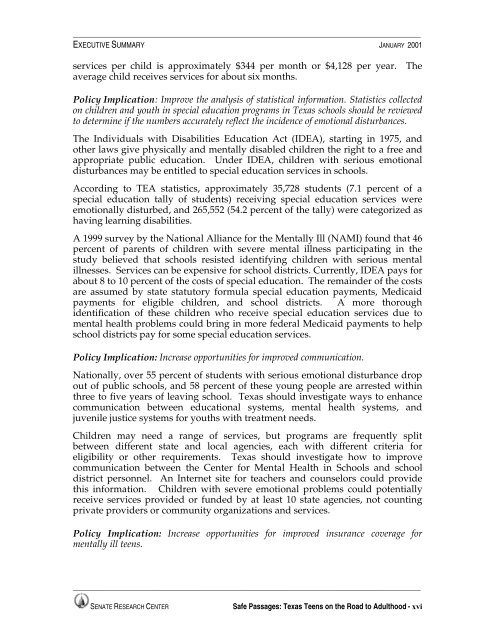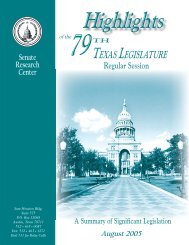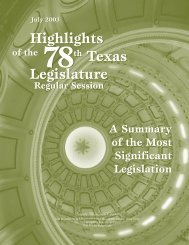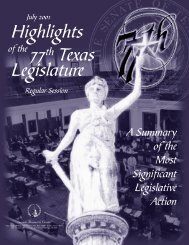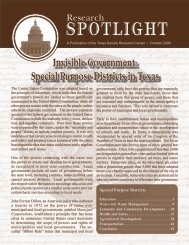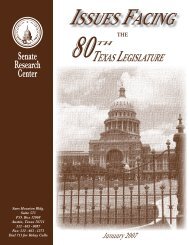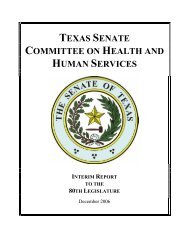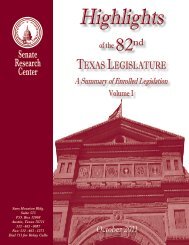Texas Teens Cover - Senate
Texas Teens Cover - Senate
Texas Teens Cover - Senate
Create successful ePaper yourself
Turn your PDF publications into a flip-book with our unique Google optimized e-Paper software.
______________________________________________________________________________________<br />
EXECUTIVE SUMMARY JANUARY 2001<br />
services per child is approximately $344 per month or $4,128 per year. The<br />
average child receives services for about six months.<br />
Policy Implication: Improve the analysis of statistical information. Statistics collected<br />
on children and youth in special education programs in <strong>Texas</strong> schools should be reviewed<br />
to determine if the numbers accurately reflect the incidence of emotional disturbances.<br />
The Individuals with Disabilities Education Act (IDEA), starting in 1975, and<br />
other laws give physically and mentally disabled children the right to a free and<br />
appropriate public education. Under IDEA, children with serious emotional<br />
disturbances may be entitled to special education services in schools.<br />
According to TEA statistics, approximately 35,728 students (7.1 percent of a<br />
special education tally of students) receiving special education services were<br />
emotionally disturbed, and 265,552 (54.2 percent of the tally) were categorized as<br />
having learning disabilities.<br />
A 1999 survey by the National Alliance for the Mentally Ill (NAMI) found that 46<br />
percent of parents of children with severe mental illness participating in the<br />
study believed that schools resisted identifying children with serious mental<br />
illnesses. Services can be expensive for school districts. Currently, IDEA pays for<br />
about 8 to 10 percent of the costs of special education. The remainder of the costs<br />
are assumed by state statutory formula special education payments, Medicaid<br />
payments for eligible children, and school districts. A more thorough<br />
identification of these children who receive special education services due to<br />
mental health problems could bring in more federal Medicaid payments to help<br />
school districts pay for some special education services.<br />
Policy Implication: Increase opportunities for improved communication.<br />
Nationally, over 55 percent of students with serious emotional disturbance drop<br />
out of public schools, and 58 percent of these young people are arrested within<br />
three to five years of leaving school. <strong>Texas</strong> should investigate ways to enhance<br />
communication between educational systems, mental health systems, and<br />
juvenile justice systems for youths with treatment needs.<br />
Children may need a range of services, but programs are frequently split<br />
between different state and local agencies, each with different criteria for<br />
eligibility or other requirements. <strong>Texas</strong> should investigate how to improve<br />
communication between the Center for Mental Health in Schools and school<br />
district personnel. An Internet site for teachers and counselors could provide<br />
this information. Children with severe emotional problems could potentially<br />
receive services provided or funded by at least 10 state agencies, not counting<br />
private providers or community organizations and services.<br />
Policy Implication: Increase opportunities for improved insurance coverage for<br />
mentally ill teens.<br />
______________________________________________________________________________________<br />
SENATE RESEARCH CENTER<br />
Safe Passages: <strong>Texas</strong> <strong>Teens</strong> on the Road to Adulthood - xvi


